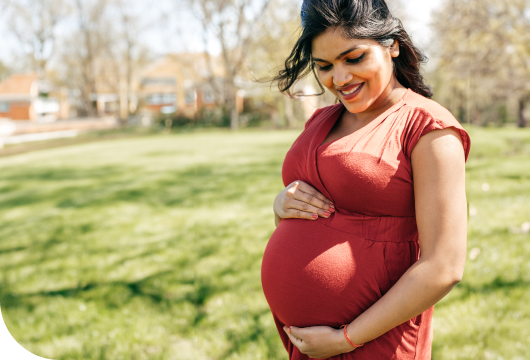Understanding gestational diabetes
In Australia, around one in every six pregnant women will develop gestational diabetes. If you have just been diagnosed with gestational diabetes, it is important to know that you are not alone. There is help and support available to you.
You probably have many questions about gestational diabetes and what it means for you and your baby. This information will help you understand gestational diabetes a little better.
What is gestational diabetes?
Diabetes is a condition where there is too much glucose (sugar) in the bloodstream. Gestational diabetes is a type of diabetes that happens during pregnancy.
Glucose is an important source of energy for your body. It comes from carbohydrate (carb) foods, such as bread, pasta, rice, cereals, fruits, starchy vegetables, milk and yoghurt. Your body breaks down carbohydrates into glucose, which then enters your bloodstream.
Insulin is needed to allow glucose from the bloodstream to enter the body’s cells and be used for energy. Insulin is a hormone made in the body by your pancreas.

During your pregnancy
During pregnancy, some of the hormones made by the placenta (which provides nutrition for your growing baby) reduce how well your body’s insulin works. This is called insulin resistance.
When insulin resistance happens, your pancreas must make extra insulin to keep blood glucose levels in the healthy range. If you cannot make enough insulin, blood glucose levels rise, and you can develop gestational diabetes.
Gestational diabetes usually develops around the 24th to 28th week of pregnancy, but it can happen earlier. For most women, diabetes goes away after the baby is born.
Find out more
Facts about gestational diabetes
Diabetes is a condition where there is high glucose in your blood.
Gestational diabetes is a type of diabetes that can happen in pregnancy.
Some pregnancy hormones reduce how well insulin works.
It usually develops around weeks 24 to 28 of pregnancy but can happen earlier.
For most women, diabetes goes away after the baby is born.
Gestational diabetes can happen to anyone, it is not your fault.

Finding out you have gestational diabetes
You will usually be checked for gestational diabetes around the 24th to 28th week of pregnancy. Women who have risk factors for gestational diabetes may be checked earlier in their pregnancy.
How is gestational diabetes diagnosed?
To check for gestational diabetes, you need to have an oral glucose tolerance test (OGTT). This test takes about 2 hours and is done at a pathology service.
First, you need to have a fasting blood test (this means you do not eat for 8–12 hours before the test).
After that, you drink a glucose drink and have your blood tested again one and two hours later. You will be asked to sit and wait between tests.
If your blood glucose is above what it should be in any of these tests, you have gestational diabetes.
Even if your blood glucose levels are only just above the healthy range, you still have gestational diabetes. Your health professionals will discuss your results and work with you to develop a plan for managing it.
Blood glucose levels just above the healthy range still need to be carefully managed.

Why some people get gestational diabetes
Gestational diabetes can happen to anyone. But there are some factors that can put you at an increased risk. We call these risk factors. Knowing the risk factors can help you understand why gestational diabetes may have developed.
- There are many different risk factors for gestational diabetes.
- Some women will also develop gestational diabetes without any of these known risk factors.
- Remember, it is not your fault. You have not done anything to cause gestational diabetes.
Your risk of developing gestational diabetes may be higher because:
Your family history
Having a family history of type 2 diabetes or a first-degree relative (mother or sister) who has had gestational diabetes increases your risk.
Your background
Being from an Aboriginal and Torres Strait Islander, African, Melanesian, Polynesian, South Asian, Chinese, Southeast Asian, Middle Eastern, Hispanic or South American background increases your risk.
Your age
Your risk increase as you get older, especially after 40 years of age.
Your weight
Having weight above the healthy range or gaining weight too rapidly in first half of pregnancy increases your risk.
Your medical history
Having gestational diabetes in a past pregnancy, high glucose levels, a large baby or complications in previous pregnancy, polycystic ovary syndrome increases your risk.
Medication
Taking antipsychotic or steroid medications increases your risk.
Why you need to manage gestational diabetes
There are some increased risks for you and your baby when you have gestational diabetes. These include the risk of developing high blood pressure in pregnancy, having a large baby or your baby having low blood glucose levels at birth.
Managing gestational diabetes reduces the risk of these health problems and helps to keep you and your baby healthy.
Your health professionals can work with you to help keep your blood glucose levels in the healthy range to provide the best outcome for both you and your baby.
Find out how to manage gestational diabetes.

NDSS is here to help
Call the NDSS Helpline 1800 637 700 and ask to speak to a health professional about your gestational diabetes.